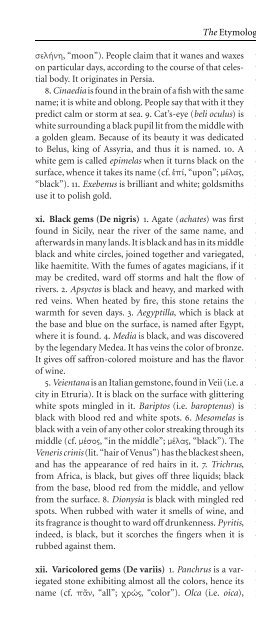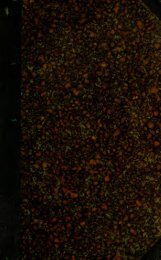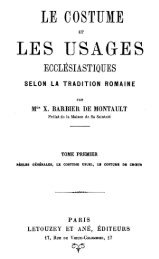The Etymologies of Isidore of Seville - Pot-pourri
The Etymologies of Isidore of Seville - Pot-pourri
The Etymologies of Isidore of Seville - Pot-pourri
You also want an ePaper? Increase the reach of your titles
YUMPU automatically turns print PDFs into web optimized ePapers that Google loves.
,“moon”). People claim that it wanes and waxes<br />
on particular days, according to the course <strong>of</strong> that celestial<br />
body. It originates inPersia.<br />
8. Cinaedia is found in the brain <strong>of</strong> a fish with the same<br />
name; it is white and oblong. People say that with it they<br />
predict calm or storm at sea. 9. Cat’s-eye (beli oculus) is<br />
white surrounding a black pupil lit from the middle with<br />
agolden gleam. Because <strong>of</strong> its beauty it was dedicated<br />
to Belus, king <strong>of</strong> Assyria, and thus it is named. 10. A<br />
white gem is called epimelas when it turns black on the<br />
surface, whence it takes its name (cf. ,“upon”; ,<br />
“black”). 11. Exebenus is brilliant and white; goldsmiths<br />
use it to polish gold.<br />
xi. Black gems (De nigris) 1. Agate(achates) was first<br />
found in Sicily, near the river <strong>of</strong> the same name, and<br />
afterwards in many lands. It is black and has in its middle<br />
black and white circles, joined together and variegated,<br />
like haemitite. With the fumes <strong>of</strong> agates magicians, if it<br />
may be credited, ward <strong>of</strong>f storms and halt the flow <strong>of</strong><br />
rivers. 2. Apsyctos is black and heavy, and marked with<br />
red veins. When heated by fire, this stone retains the<br />
warmth for seven days. 3. Aegyptilla, whichisblack at<br />
the base and blue on the surface, is named after Egypt,<br />
where it is found. 4. Media is black, and was discovered<br />
by the legendary Medea. It has veins the color <strong>of</strong> bronze.<br />
It gives <strong>of</strong>f saffron-colored moisture and has the flavor<br />
<strong>of</strong> wine.<br />
5. Veientana is an Italian gemstone, found in Veii (i.e. a<br />
city in Etruria). It is black on the surface with glittering<br />
white spots mingled in it. Bariptos (i.e. baroptenus) is<br />
black with blood red and white spots. 6. Mesomelas is<br />
black with a vein <strong>of</strong> any other color streaking through its<br />
middle (cf. ,“in the middle”; ,“black”). <strong>The</strong><br />
Veneris crinis (lit. “hair <strong>of</strong> Venus”) has the blackest sheen,<br />
and has the appearance <strong>of</strong> red hairs in it. 7. Trichrus,<br />
from Africa, is black, but gives <strong>of</strong>f three liquids; black<br />
from the base, blood red from the middle, and yellow<br />
from the surface. 8. Dionysia is black with mingled red<br />
spots. When rubbed with water it smells <strong>of</strong> wine, and<br />
its fragrance is thought to ward <strong>of</strong>f drunkenness. Pyritis,<br />
indeed, is black, but it scorches the fingers whenitis<br />
rubbed against them.<br />
xii. Varicolored gems (De variis) 1. Panchrus is avariegated<br />
stone exhibiting almost all the colors, hence its<br />
name (cf. , “all”; , “color”). Olca (i.e. oica),<br />
<strong>The</strong> <strong>Etymologies</strong> XVI.x.8–xiii.2 325<br />
which has a barbarian name, is yellow, black, green and<br />
white. 2. Mithridax (i.e. mithrax)glitters in various colors<br />
when it is struck by sunlight. It comes from Persia.<br />
Drosolithus is a variegated gem. <strong>The</strong> reason for its name<br />
is that if it is placed near the fire it emits something like<br />
sweat (cf. , “sweat”; , “stone”). 3. <strong>The</strong>opal<br />
(opalus) isembellished by the colors <strong>of</strong> various gemstones,<br />
for it has the rather pale fire <strong>of</strong> a carbuncle, the<br />
sparkling purple <strong>of</strong> an amethyst, and the glittering green<br />
<strong>of</strong> a smaragdus, all glowing together with a certain variegation.<br />
It takes its name from the language <strong>of</strong> its native<br />
land (cf. Sanskrit upala,“gem”),foronlyIndia produces<br />
it. 4. Pontica stones are named after the Pontus (i.e. the<br />
Black Sea), and come in different varieties, at one time<br />
glittering with blood red spots, at another with gold<br />
spots. Some have stars and some are streaked with long<br />
lines <strong>of</strong> color. 5. Hexecontalithos is a multicolored stone<br />
<strong>of</strong> a small size, whence it has taken this name for itself,<br />
for it is sprinkled with such avariety <strong>of</strong> spots that the<br />
colors <strong>of</strong> sixty gemstones are contained in its small orb<br />
(cf. ,“sixty”; ,“stone”). It occurs in Libya<br />
among the Troglodytes. 6. Murra (murrina) isfoundin<br />
Parthia, but especially in Carmania. People think that it<br />
is a liquid that has been compressed by the heat under<br />
the earth, whence it takes its name. Its varieties occur in<br />
purple and white, and it has a fiery look, with reflections<br />
<strong>of</strong> colors such as are seen in a rainbow. Crystal is created<br />
by the opposite principle, when there is an extremely<br />
strong freezing <strong>of</strong> ice.<br />
xiii. Crystalline gems (De crystallinis) 1.Crystal (crystallus)<br />
isglittering and watery in color. It is said to be<br />
snow that has hardened to ice over a period <strong>of</strong> years,<br />
whence the Greeks gave it its name (cf. ,<br />
“ice”). It occurs in Asia and Cyprus, and particularly in<br />
the northern part <strong>of</strong> the Alps, where the sun never has<br />
its most burning heat, not even in summer. Hence the<br />
lengthy and enduring hardness itself produces the specific<br />
form that is called ‘crystal.’ When crystal is placed<br />
facing the sun’s rays it seizes the flame so that it sets fire<br />
to dried fungus or leaves. It is used for cups, although it<br />
can handle only cold liquids.<br />
2. <strong>The</strong> diamond (adamans, i.e. adamas) isasmall<br />
unsightly stone from India, possessing a rust-like color<br />
and the clarity <strong>of</strong> crystal. It is never found any larger<br />
than a hazelnut. It yields to no substance, neither to iron<br />
nor to fire, nor does it ever grow warm, whence it takes

















